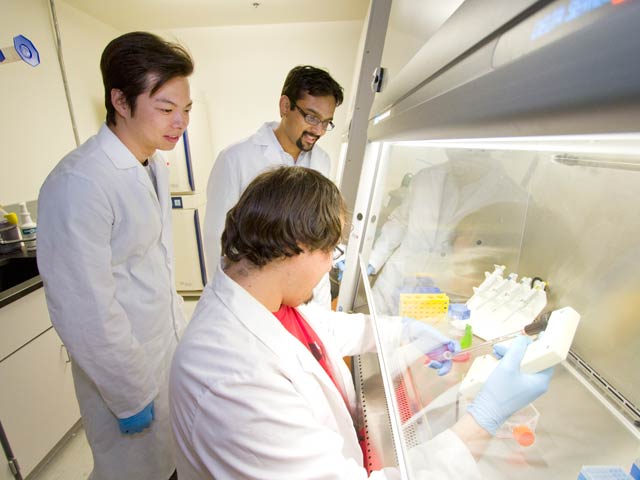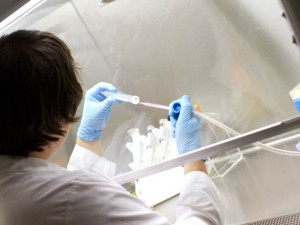
Students play role in research to advance health, public safety

 Kaushal Rege is working at the forefront of chemical engineering research that promises to produce far-reaching beneficial impacts on human health, public safety and national security.
Kaushal Rege is working at the forefront of chemical engineering research that promises to produce far-reaching beneficial impacts on human health, public safety and national security.
He’s also providing students opportunities to not only learn about the research as it happens but enabling them to help make it happen.
Rege is an assistant professor in the School for Engineering of Matter, Transport and Energy, one of the Ira A. Fulton Schools of Engineering at Arizona State University.
With support of a $1.48 million grant from the National Institutes of Health, he is pursuing advances in battling cancer by engineering polymers (compound materials made by combining different kinds of molecules) that can be used to deliver therapeutic genes directly to cancer cells in the body.
The process is designed to overcome the negative effects of unhealthy genes by administering healthy genes on a cellular level directly at the source of the cancer.
The method involves generating several polymers that are rapidly screened to identify the particular ones most effective for delivering therapeutic genes. These genes then produce proteins that can kill cancer cells.
A key advance employed in the research involves use of cutting-edge computational methods for correlating the chemical properties of polymers with their ability to deliver genes within the body.
Rege is collaborating on various aspects of this research with partners at the Medical University of South Carolina and Rensselaer Polytechnic Institute in New York.
In a project supported by a $200,000 Young Investigator Award from the Defense Threat Reduction Agency of the U.S. Department of Defense, Rege is also doing work on “smart materials.” The project focuses on assembling polypeptide nanoparticles in ways that can be used for detecting thermal changes (changes in heat).
A polypeptide is a chain of amino acids linked together by peptide bonds. Many hormones and antibiotics are peptides.
Cylindrical gold nanoparticles (called nanorods) convert near infra-red light to heat (the photothermal effect), which induces changes in polypeptide structures, Rege explains. This, in turn, induces the liquid nano-assemblies to change to solid-phase materials, which is a visual indicator of photothermal changes.
Using different kinds of nanoparticles in this process can produce materials that are effective in sensing different forms of radiation, he says.
Sensors that can detect radiation, thermal (heat) and magnetic changes can be effective in indicating when major weapons testing by foreign nations has occurred or detecting the presence of certain weapons-grade materials.
Several chemical and biomedical engineering graduate students work as lab assistants for Rege on the cancer treatment and chemical-detection projects.
Other ASU students are involved in the work through the engineering schools’ Fulton Undergraduate Research Initiative, which enables undergrads to participate in advanced research.
In addition, for a third straight year Rege is involved in an education outreach program with the Mesa Public Schools Biotechnology Academy. The program brings two of the academy’s high school students to Rege’s lab during each school year to be mentored on the basics of chemical and biological engineering research.
Using what they’ve learned in Rege’s lab, the high school students have been successful in competitions at the annual Arizona Science and Engineering Fair.
“All of our students who have been mentored by Dr. Rege have won medals at the Arizona Science and Engineering Fair, and one used her work to help qualify for the prestigious Wood Scholar program,” says Biotechnology Academy director Amanda Grimes.
“The in-depth knowledge the students gain about complex molecules, polymer generation and the effects of various molecules on cancer cells makes their research stand out from that of their peers.” Grimes says.
“Their future careers in research and medicine will be better because of their early exposure to the world of chemical engineering,” she says. “The knowledge and experiences gained by the internship will help them make smooth transitions from the school environment to working in industry or in academia.”
Academy student Merissa Fynan says her internship in Rege’s lab “made me feel better prepared and more confident in the information I had when I presented my research project at local and state competitions.”
The experience, she says, “has given me great preparation for what I expect to see when I get into college-level research.”
This article appeared in ASU News on October 25, 2011.



































